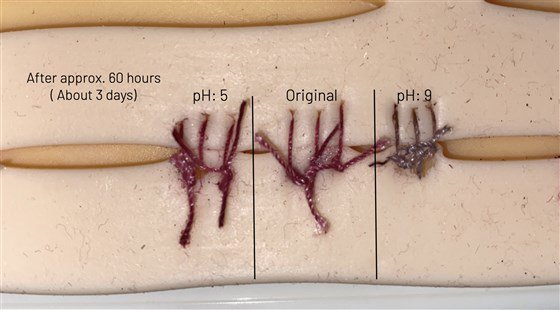Iowa high schooler Dasia Taylor used the vegetable juice to dye sutures, which could theoretically be used to detect infections.
“My project is a novel suture additive that uses beet extract to assess surgical wound infection,” Taylor says. The beet-juice sutures work by changing color when they detect infection at the site of a wound. Human skin is weakly acidic, with a pH of about 6. But upon infection, that pH level grows as the skin becomes even more acidic. Beet juice, then changes from red to purple in the midst of that specific range of pH change.
“With my sutures, those surgical site infections would be able to be detected quicker, thus lowering the amount of people who die from surgical site infections in developing countries,” Taylor adds .
Taylor's research earned her a spot among the 300 finalist in a nationwide contest for high school seniors put on by Society for Science.
Taylor's interest in surgical sutures began a few years prior, after being given a set for Christmas.

The impetus for her color-changing sutures came from learning about "smart sutures," which can warn of infection via changes in a wound's electrical resistance. Infections after Cesarean sections particularly caught Taylor’s attention. In some African nations, up to 20% of women who give birth by C-section then develop surgical site infections.
Figuring out the correct material to use for the color-changing sutures proved the most challenging part-a grinding process of trial-and-error. Taylor also needed to learn how to work in a sterile environment to test the sutures with bacteria provided by Iowa City West.
Next, Taylor had to find a suture thread that would hold onto the dye. She tested ten different materials, including standard suture thread, for how well they picked up and held the dye, whether the dye changed color when its pH changed, and how their thickness compared to standard suture thread.

A cotton-polyester blend checked all the boxes. After five minutes under an infection-like pH, the cotton-polyester thread changes from bright red to dark purple. After three days, the purple fades to light gray.
Despite their potential promise, there are several drawbacks to the beet-juice sutures. Kathryn Chu, the director of the Centre for global surgery at Stellenbosch University in South Africa spoke with Smithsonian Magazine, and, after praising the work, noted that “if the infection oozes through the skin, or involves the skin, the infection has already reached later stages.
Regardless of their ultimate efficacy, the sutures help to bring attention to the disparity in surgical site infections in the first world and developing countries.
Source: Nerdist.




















Its very useful scientific fact.It s very informative article .and also I enjoyed the way it is written with proven facts.thanks alot
Dr Kinnar Desai
Vadodara